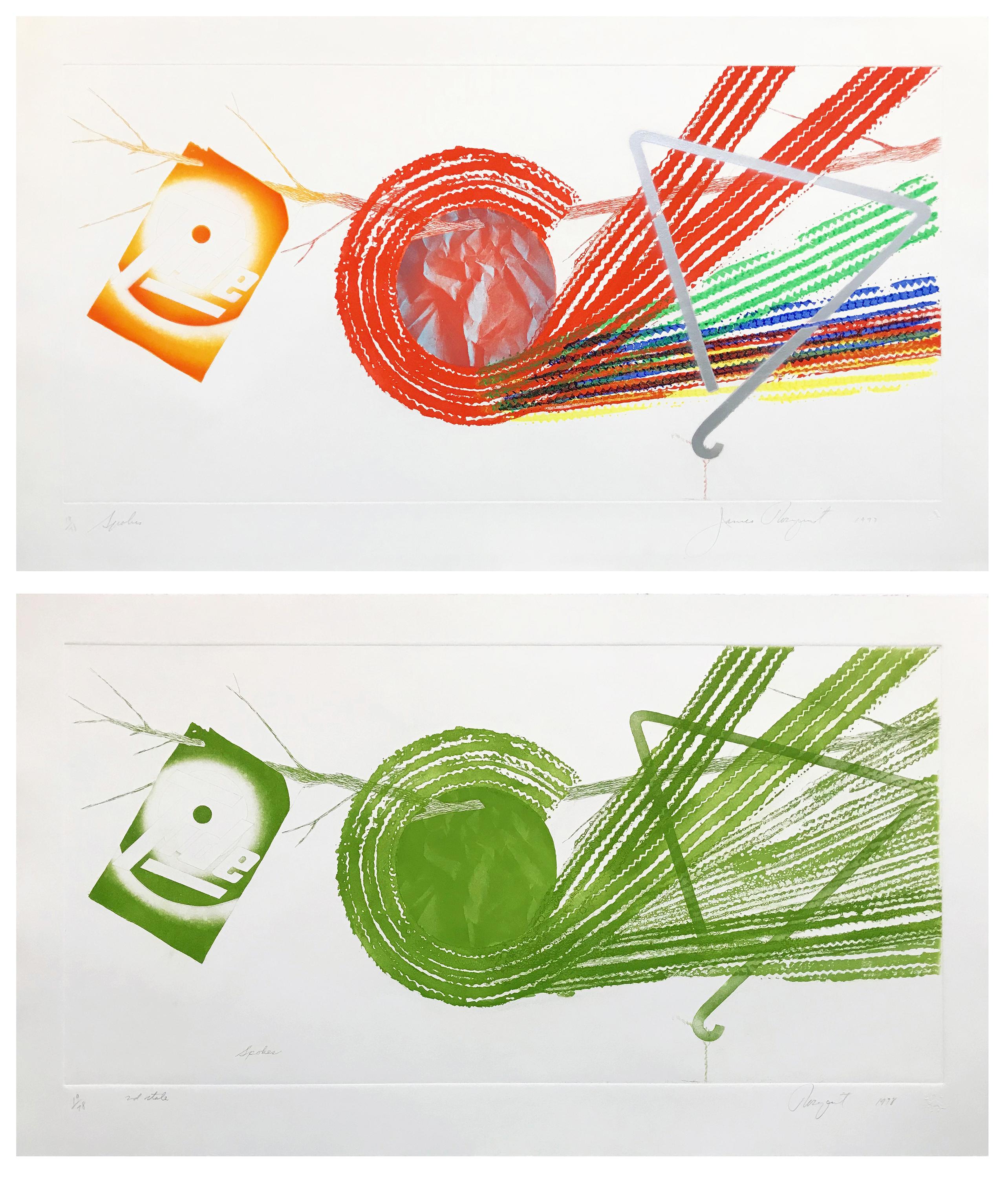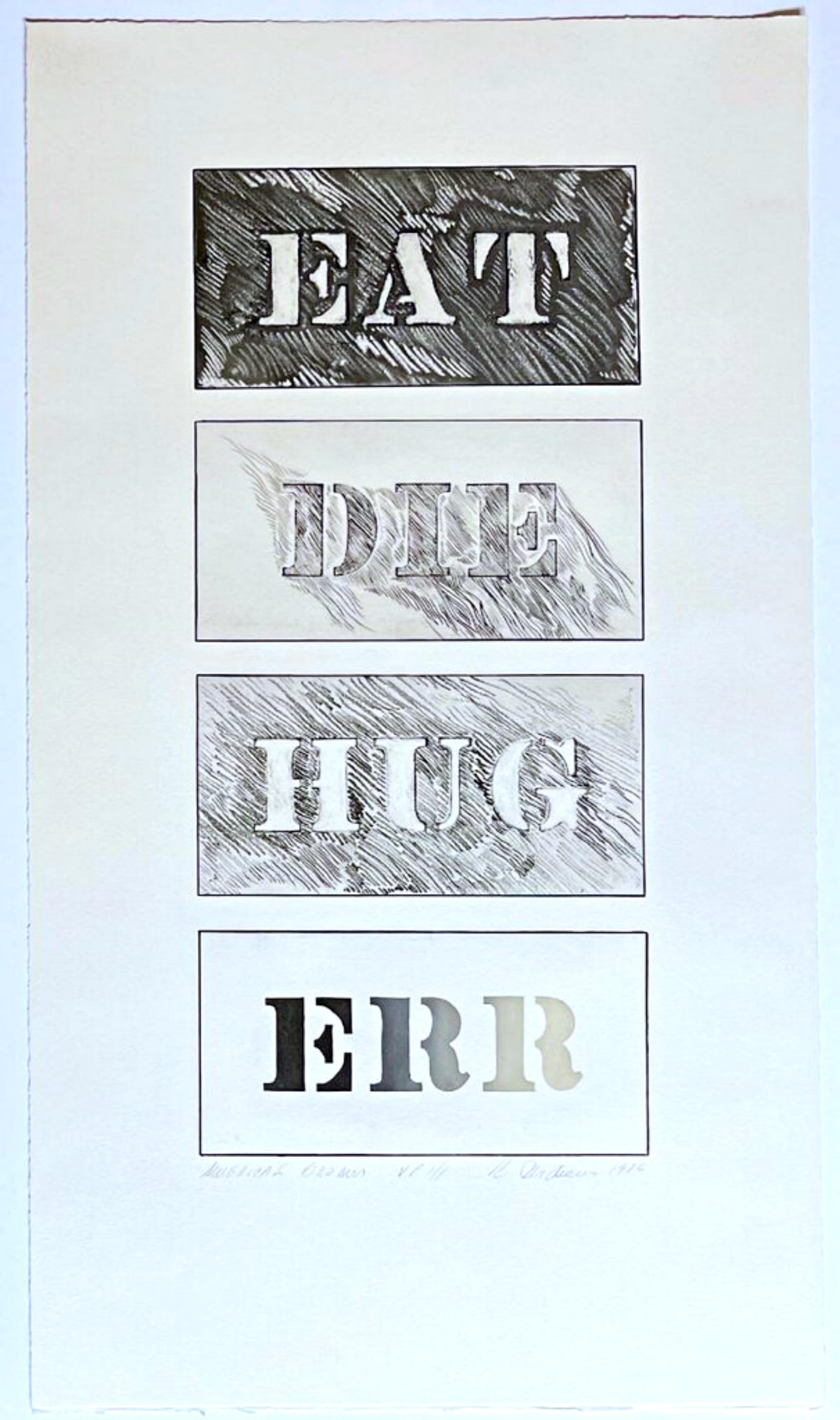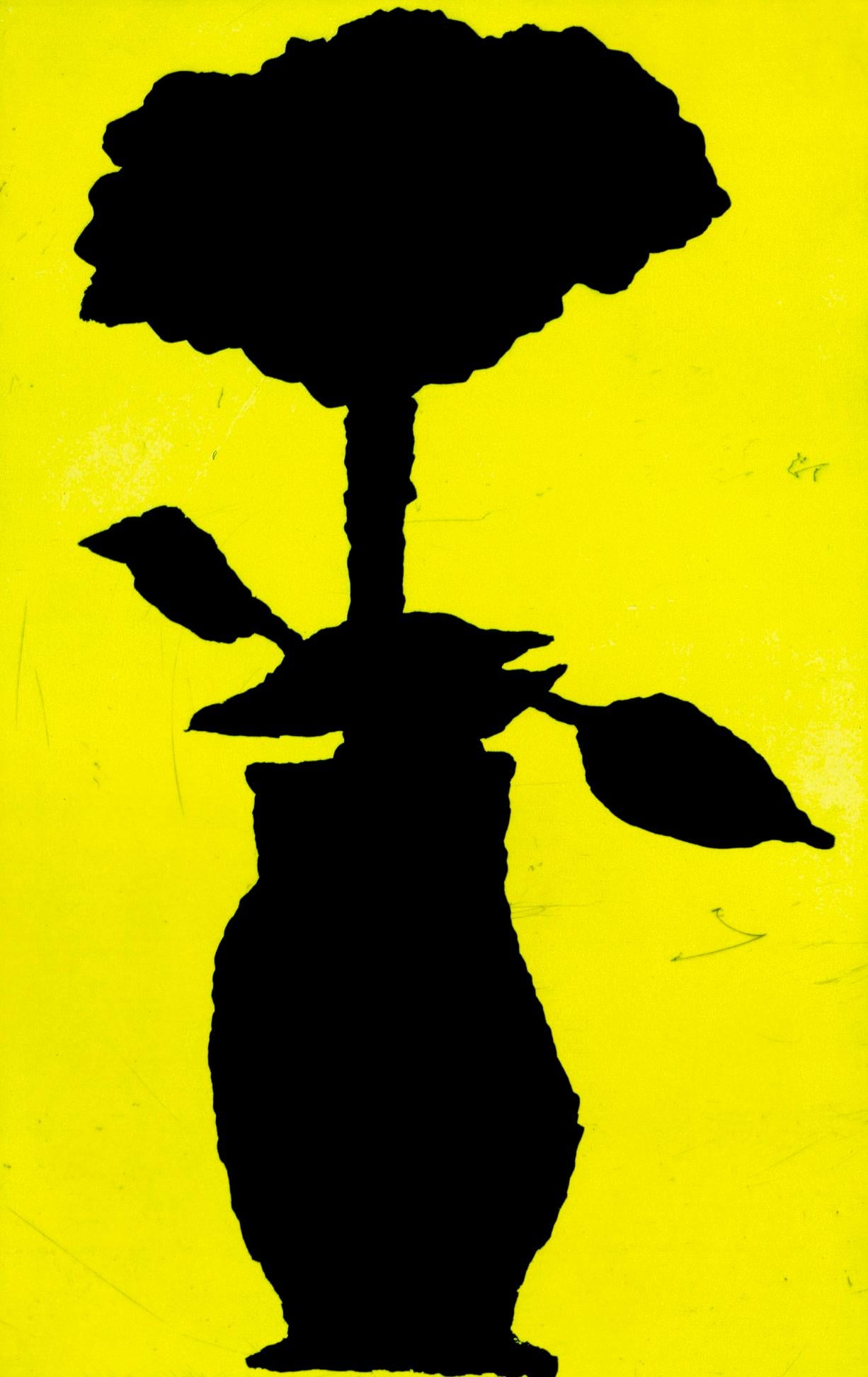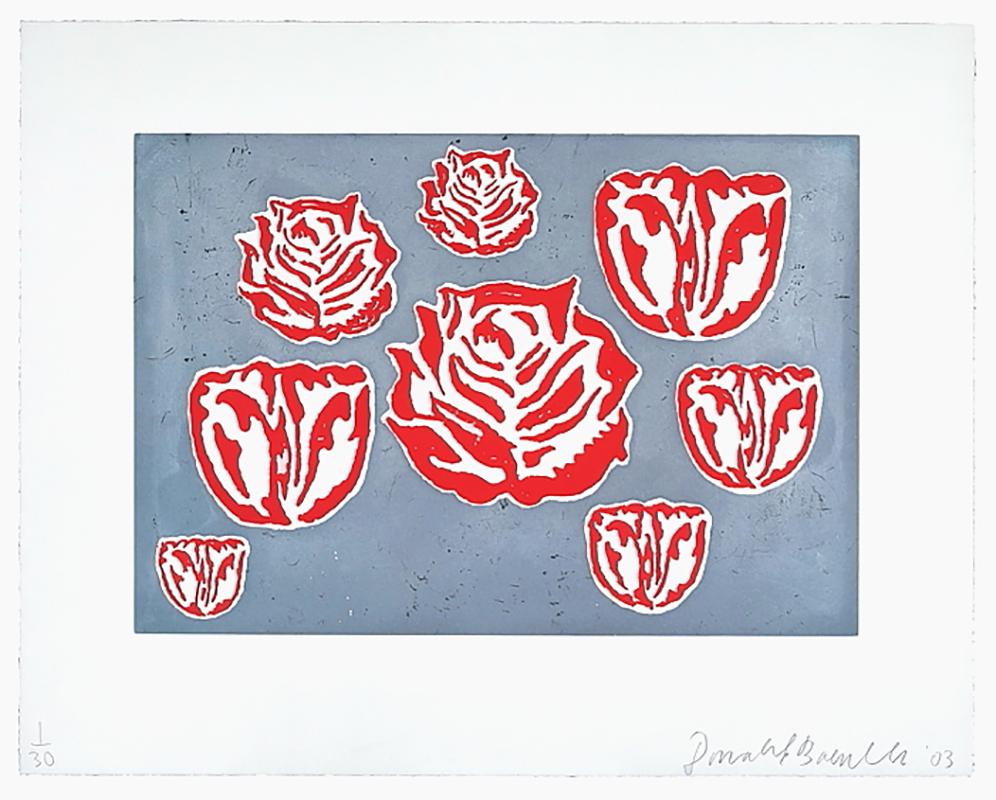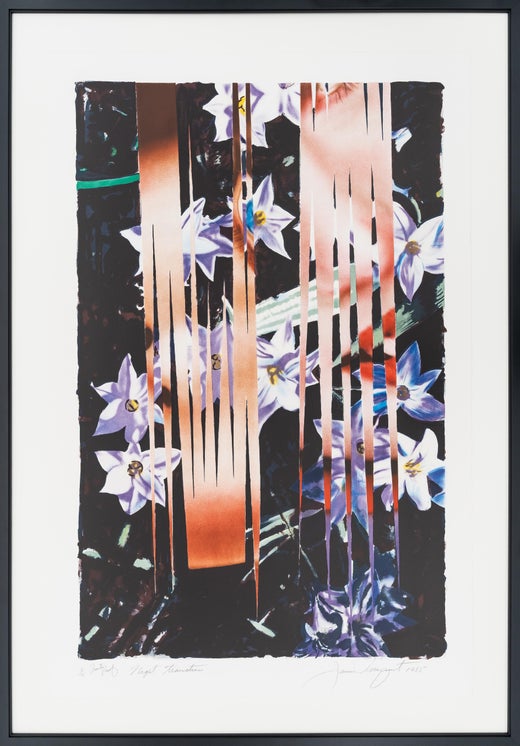James RosenquistLarge American Pop Art Abstract Aquatint Etching James Rosenquist Just Desert1979
1979
About the Item
- Creator:James Rosenquist (1933, American)
- Creation Year:1979
- Dimensions:Height: 23 in (58.42 cm)Width: 40 in (101.6 cm)
- Medium:
- Movement & Style:
- Period:
- Condition:
- Gallery Location:Surfside, FL
- Reference Number:1stDibs: LU38214399272
James Rosenquist
Although he insisted that he and his fellow Pop artists developed their art-making styles independently, American painter James Rosenquist belonged at the table with Andy Warhol and Roy Lichtenstein.
Known for his distinctive use of visual montage, Rosenquist produced large, vibrantly colored tableaux marked by fragmentation and overlap. He often employed familiar motifs and objects drawn from popular contemporary culture — hot dogs, lipstick tubes, American flags — which he manipulated to form disorienting compositions whose constituent elements are nearly unrecognizable.
Born in North Dakota to Swedish parents, Rosenquist was encouraged to pursue painting by his mother, who was also an artist. He studied painting for two years at the University of Minnesota, but dropped out at the age of 21 to attend the Art Students League in New York on a scholarship. A job as a billboard painter in the late 1950s set him up to pursue his signature style, which borrowed its bold graphics and remixed kitschy aesthetic from the visual vocabulary of advertising. Works like Flamingo Capsule (1983) embody his trademark visual dissonance, drawing cigarette-ad motifs into conversation with stripes from the American flag and aluminum foil wrappers.
In addition to enormous paintings, Rosenquist created drawings, prints and collages. The 2011 lithograph The Memory Continues but the Clock Disappears is a montage of melting clocks and confetti, all submerged in a pool of water. While wryly hinting at the inevitability of decay and deterioration — suggesting that life is a ticking clock — the composition also alludes to Salvador Dalí's signature motif, the defining symbol of Surrealism. Such compositions demonstrate how Rosenquist masterfully combined seemingly incongruous elements into a harmonious and poetic whole.
Find James Rosenquist art today on 1stDibs.
- ShippingRetrieving quote...Ships From: Surfside, FL
- Return PolicyA return for this item may be initiated within 3 days of delivery.
- Surrealist Figurative Aquatint Etching California Modernist Sculptor ArtistBy Jack ZajacLocated in Surfside, FLJack Zajac, American, born 1929 1964 Etching and aquatint hand printed on Fabriano paper, pencil signed and editioned. Edition Roman Numeral III Image: 12 9/16 x 8 5/8 in. (31.9 x 2...Category
1960s Surrealist Figurative Prints
MaterialsEtching, Aquatint
- Iranian Israeli Large Aquatint Etching Figurative Abstract Circus Monde BalloonsBy Elie (Eliahu) AbrahamiLocated in Surfside, FLBright colorful abstract circus scene with balloons. Born in 1941 in Sanandaj, Iran and immigrated to Israel at the age of 17. Elie Abrahami began his study of art at the Avni School...Category
20th Century Abstract Figurative Prints
MaterialsAquatint
- Surrealist Figurative Aquatint Etching California Modernist Sculptor ArtistBy Jack ZajacLocated in Surfside, FLJack Zajac, American, born 1929 1964 Etching and aquatint hand printed on Fabriano paper, pencil signed and editioned. This one depicts winged angels. Edition Roman Numeral III Ima...Category
1960s Surrealist Figurative Prints
MaterialsEtching, Aquatint
- Surrealist Figurative Aquatint Etching California Modernist Sculptor ArtistBy Jack ZajacLocated in Surfside, FLJack Zajac, American, born 1929 1964 Etching and aquatint hand printed on Fabriano paper, pencil signed and editioned. Edition Roman Numeral III Image: 12 9/16 x 8 5/8 in. (31.9 x 2...Category
1960s Surrealist Figurative Prints
MaterialsEtching, Aquatint
- Surrealist Figurative Aquatint Etching California Modernist Sculptor ArtistBy Jack ZajacLocated in Surfside, FLJack Zajac, American, born 1929 1964 Etching and aquatint hand printed on Fabriano paper, pencil signed and editioned. Edition Roman Numeral III Image: 12 9/16 x 8 5/8 in. (31.9 x 2...Category
1960s Surrealist Figurative Prints
MaterialsEtching, Aquatint
- Surrealist Figurative Aquatint Etching California Modernist Sculptor ArtistBy Jack ZajacLocated in Surfside, FLJack Zajac, American, born 1929 1964 Etching and aquatint hand printed on Fabriano paper, pencil signed and editioned. Edition Roman Numeral III Image: 12 9/16 x 8 5/8 in. (31.9 x 2...Category
1960s Surrealist Figurative Prints
MaterialsEtching, Aquatint
- SPOKES AND SPOKES: 2 STATEBy James RosenquistLocated in Aventura, FLSpokes (1977) and Spokes: 2 State (1978). Each hand signed, dated, numbered and titled by the artist. Both prints have matching editions. Etching and aquatint on Pescia Italia paper....Category
1970s Pop Art Abstract Prints
MaterialsEtching, Aquatint
- American Dream (EAT / DIE / HUG / ERR) (Sheehan 136) UNIQUE Proof Love Food LifeBy Robert IndianaLocated in New York, NYRobert Indiana American Dream (EAT / DIE / HUG / ERR) (Sheehan, 136), 1986 Hard and soft-ground etching, aquatint, drypoint and stencil on white Arches paper 37 inches × 21 inches ...Category
1980s Pop Art Abstract Prints
MaterialsMixed Media, Drypoint, Etching, Aquatint, Stencil
- Donald Baechler Flower 2005 (Donald Baechler flower prints)By Donald BaechlerLocated in NEW YORK, NYDonald Baechler "Flower," 2005: Medium: Aquatint and dry-point on Somerset paper. Sheet size: 25 1⁄2 x 18 inches. Image: 17.25 x 11 inches. Edition of 34 +5 AP. Hand signed, dated a...Category
21st Century and Contemporary Pop Art Figurative Prints
MaterialsDrypoint, Aquatint
- SPOKES: 2 STATEBy James RosenquistLocated in Aventura, FLHand signed, dated, numbered and titled by the artist. Etching and aquatint on Pescia Italia paper. Edition of 78. Published by Multiples, Inc. Sheet size 23 x 40 inches. Frame si...Category
1970s Pop Art Abstract Prints
MaterialsEtching, Aquatint
- SPOKESBy James RosenquistLocated in Aventura, FLHand signed, dated, numbered and titled by the artist. Etching and aquatint on Pescia Italia paper. Edition of 78. Published by Multiples, Inc. Sheet size 23 x 40 inches. Frame si...Category
1970s Pop Art Abstract Prints
MaterialsEtching, Aquatint
- Donald Baechler Szechuan Garden 2003 (Donald Baechler prints)By Donald BaechlerLocated in NEW YORK, NYDonald Baechler, Szechuan Garden, 2003: Medium: Aquatint and soft-ground etching. Sheet size: 27 x 34 inches. Edition of 35 (30 + 5 artists proofs). Hand-signed, dated and numbered on bottom of sheet. Printed on Hanhnemuhle paper. Unframed. Acquired directly from publisher. Artist Biography: Donald Baechler, a member of the East Village art scene in 1980s New York, is known for his painting-collage-drawing works depicting of childhood imagery and nostalgic ephemera like grammar school primers, old maps, and children’s drawings...Category
21st Century and Contemporary Pop Art Figurative Prints
MaterialsEtching, Aquatint
